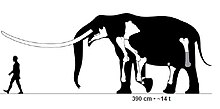

| Mammutidae
| |
|---|---|

| |
| Mounted Mammut skeleton, Museum of the Earth | |
| Scientific classification | |
| Domain: | Eukaryota |
| Kingdom: | Animalia |
| Phylum: | Chordata |
| Class: | Mammalia |
| Order: | Proboscidea |
| Clade: | Elephantimorpha |
| Clade: | †Mammutida |
| Superfamily: | †Mammutoidea Hay, 1922[2] |
| Family: | †Mammutidae Hay, 1922 |
| Genera[5] | |
|
†Eozygodon Tassy and Pickford, 1983 | |
| Synonyms | |
| |
Mammutidae is an extinct familyofproboscideans belonging to Elephantimorpha. It is best known for the mastodons (genus Mammut), which inhabited North America from the Late Miocene until their extinction at beginning of the Holocene, around 11,000 years ago. The earliest fossils of the group are known from the Late Oligocene of Africa, around 24 million years ago, and fossils of the group have also been found across Eurasia. The name "mastodon" derives from Greek, μαστός "nipple" and ὀδούς "tooth", referring to their characteristic teeth.


Mammutids are characterised by their zygodont (having the opposite cusps merged into ridges) molars which are morphologically conservative (showing little variation) amongst all members of the family.[6] Like other members of Elephantimorpha, mammutids exhibited horizontal tooth replacement like modern elephants. Some authors have argued that horizontal tooth replacement evolved in parallel in mammutids and members of Elephantida (which includes gomphotheres and elephants), though this is uncertain.[7] Early members of the group like Eozygodon and Zygolophodon had elongate mandibular symphysis of the lower jaws with lower incisors/tusks, while in later representatives like Sinomammut and Mammut, the lower incisors/tusks were either lost or only vestigially present, and the lower jaws shortened (brevirostrine). This process happened convergently amongst other elephantimorph proboscideans, including gomphotheres, stegodontids, and elephantids.[8][9] The mammutid "Mammut" borsoni is one of the largest of all proboscideans, with one specimen having an estimated mass of 16 tonnes, making it one of the largest land mammals of all time,[10] with the tusks of this species being the longest known of any mammal, reaching over 5 metres (16 ft) in length.[11]
Members of Mammutidae are thought to have been browsers.[12][13][14] Analysis of American mastodon (Mammut americanum) remains suggests that mammutids had a similar social structure to modern elephants, with herds of adult females and juveniles, with adult males living solitarily or in bonding groups with other males,[15][16] with adult males periodically engaging in musth-like fighting behaviour against other males.[15]
Mammutids are the most basal group within Elephantimorpha, with gomphotheres and other members of Elephantida like amebelodonts being more closely related to elephants.[17][18] Mammutids originated in Africa during the Late Oligocene, with the oldest genus Losodokodon dating to around 27.5-24 million years ago[19] and entered Eurasia across the "Gomphotherium land bridge" during the early Miocene, around 18 million years ago. Mammutid remains are generally rare in Eurasia in comparison to contemporary gomphotheres and deinotheres.[6] During the late early Miocene, around 16.5 million years ago,[20] a population of Zygolophodon entered North America, giving rise to Mammut.[6] The youngest confirmed records of mammutids in Africa date to around 13 million years ago, though possible Late Miocene fossils have been reported from North Africa.[21] At the beginning of the Pleistocene, around 2 to 2.5 million years ago, the last of the Eurasian mammutids, "Mammut" borsoni became extinct, with members of Mammut persisting in North America until the end of the Pleistocene, approximately 11,000 years ago.[6]
|
Genera of the order Proboscidea
| ||||||||||||||||||||||||||||||
|---|---|---|---|---|---|---|---|---|---|---|---|---|---|---|---|---|---|---|---|---|---|---|---|---|---|---|---|---|---|---|
| ||||||||||||||||||||||||||||||
|

| |||||||||||||||||||||||||||||
| ||||||||||||||||||||||||||||||
| Mammutidae |
|
|---|---|